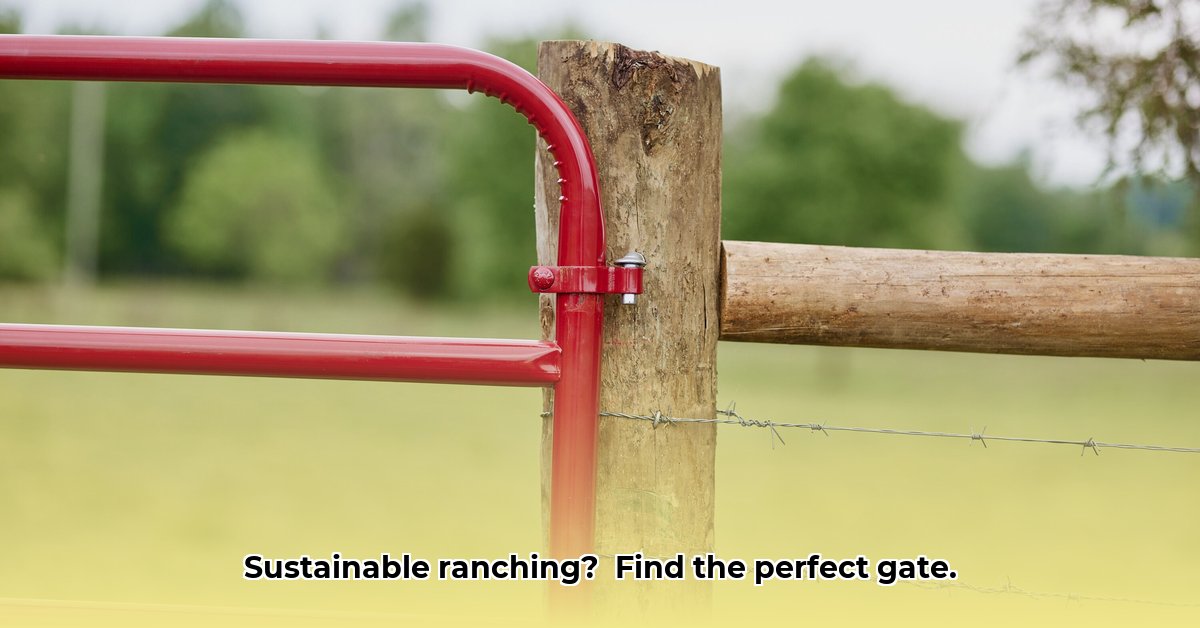
Choosing the right livestock gates is crucial for efficient and sustainable ranching. This guide helps you select and install eco-friendly gates from Tractor Supply, maximizing both your budget and environmental responsibility. For more on water conservation in ranching, check out these water saving tips.
Material Matters: Sustainable Gate Choices
The gate material significantly impacts its lifespan, maintenance, and environmental footprint. Let's compare popular options:
| Material | Pros | Cons | Sustainability Considerations |
|---|---|---|---|
| Wood | Renewable, aesthetically pleasing, often less expensive initially | Requires regular maintenance (staining, treating), susceptible to rot | Source sustainably harvested wood; consider pressure-treated lumber for longevity; explore reclaimed wood. |
| Steel | Extremely durable, long-lasting, strong, pest-resistant | Higher initial cost, rust-prone without coatings | Choose recycled steel; powder coating offers rust protection; consider steel production energy costs. |
| Recycled Plastic | Durable, low-maintenance, weather-resistant, varied colors available | Higher initial cost than wood, may be less aesthetically pleasing to some | Ensure gates are made from 100% post-consumer recycled plastic; verify manufacturer's claims. |
The best material depends on your budget, climate, and desired lifespan. In harsh climates, steel with protective coatings might prove a more cost-effective long-term investment than wood. Isn't minimizing replacements a key aspect of sustainability?
Designing for Success: Gate Size and Style
Appropriate gate sizing prevents animal escape and simplifies livestock handling. Consider:
- Livestock Type: Gate size must accommodate your animals (cattle require larger gates than sheep).
- Terrain: Uneven terrain may necessitate reinforced gates or specialized hinges.
- Accessibility: Ensure easy opening and closing, especially during emergencies. Consider automatic latches or easy-grip handles.
- Gate Style: Swinging gates are common, but sliding gates save space and work well in challenging terrain.
Careful planning optimizes workflow and improves overall efficiency. A well-designed gate system simplifies daily routines, ultimately enhancing productivity.
Installation and Maintenance: A Step-by-Step Guide
Proper installation significantly extends gate lifespan. Follow these steps:
- Prepare Post Holes: Dig deep, well-supported holes appropriate for your soil and posts. Securing posts with concrete enhances stability, though consider the environmental impact of concrete.
- Set the Posts: Ensure posts are plumb (perfectly vertical) using a level for proper gate alignment.
- Attach the Gate: Precise alignment is vital for smooth operation.
- Install Hinges and Latches: Use heavy-duty hinges and latches rated for your livestock and gate weight.
- Regular Inspections: Regularly inspect for loose parts, damage, or wear and tear. Addressing minor issues prevents major problems.
- Maintenance: Apply protective coatings (paint or powder coating) to metal gates; treat wooden gates with preservatives.
Proactive maintenance saves money and extends gate life, significantly reducing waste and environmental impact. Is there a more cost-effective sustainable practice than preventative maintenance?
Beyond the Gates: Holistic Sustainable Ranching
Sustainable ranching is more than just eco-friendly gates. Consider:
- Rotational Grazing: Strategic gate placement enables effective pasture rotation, improving soil health and reducing overgrazing.
- Water Access: Place gates near water sources for optimized animal movement and reduced stress.
- Animal Welfare: Prioritize safe, easy-to-navigate gates minimizing injury and stress.
Integrating sustainable gate choices into a holistic approach optimizes your entire operation. Doesn’t thoughtful pasture management contribute significantly to a ranch's sustainability?
Conclusion: Building a Sustainable Future
Choosing sustainable livestock gates is an investment in your ranch's long-term health and environmental responsibility. By considering material choices, gate design, proper installation, and regular maintenance, you contribute to efficient livestock management and a reduced environmental footprint. Remember, sustainable ranching is an ongoing process, and continuous improvement is key.